

Slovenia Travel Insurance
Embarking on a journey to the enchanting landscapes and cultural treasures of Slovenia is a thrilling adventure, but ensuring a seamless and worry-free experience requires careful preparation. One essential aspect of trip planning is obtaining the right travel insurance for Slovenia.
From the picturesque shores of Lake Bled to the historic streets of Ljubljana, having comprehensive insurance coverage is not only a practical safeguard but also a fundamental component of responsible travel. In this guide, we will explore the importance of Slovenia insurance, highlighting the key factors to consider and the peace of mind it brings to those exploring this charming European destination.
Unrivalled Coverage for Your Slovenian Adventure
Unpacking Our Comprehensive Insurance Plans:
Our Slovenia Travel Insurance stands out for its comprehensive coverage, ensuring you’re well-protected throughout your journey. Key highlights include:
- Holistic Medical Coverage: We go beyond the basics, offering extensive medical coverage to address any unexpected health concerns that may arise during your stay in Slovenia.
- 24/7 Travel Assistance: Your safety is our priority. Our round-the-clock travel assistance services are designed to provide support in emergencies, such as lost belongings or unforeseen situations, ensuring you’re never alone during your travels.
- Tailored Policy Options: Recognizing the unique needs of every traveller, our insurance plans come with flexible options. Choose a policy that aligns seamlessly with your travel plans and preferences.
Exceeding Schengen Visa Insurance Requirements
Documenting Your Assurance
Our insurance not only meets but exceeds the Schengen Area requirements. With coverage extending to medical expenses, emergency evacuation, and repatriation, you can confidently present a well-documented insurance policy for your visa application.
Trusted Healthcare Networks
We’ve forged partnerships with reliable healthcare providers in Slovenia. Our network includes renowned hospitals, clinics, and healthcare professionals, ensuring you receive top-notch medical care without any hassle during your stay.
Key Guidelines For Travelers In Slovenia
Travelling to Slovenia offers a delightful mix of natural beauty, rich history, and vibrant culture. To make the most of your journey and ensure a smooth experience, here are key guidelines for travellers in Slovenia:
Valid Travel Documents: Ensure your passport is valid for at least six months beyond your planned departure date. Check visa requirements based on your nationality before travelling to Slovenia.
Health insurance: while not mandatory, having comprehensive health insurance is advisable. it can cover medical expenses in case of illness or accidents during your stay., local currency: the official currency is the euro (eur). it’s recommended to have some local currency for small expenses, but credit cards are widely accepted., weather preparedness: slovenia experiences diverse climates, so pack accordingly. check the weather forecast for your specific destination and the time of year you’re visiting., transportation: slovenia has a well-developed transportation system. renting a car allows flexibility to explore remote areas, while public transportation, including buses and trains, is efficient and connects major cities., cultural respect: slovenians take pride in their cultural heritage. respect local customs and traditions, and remember to greet people with a friendly “dober dan” (good day) or “zdravo” (hello)., language: slovenian is the official language, but english is widely spoken in tourist areas. learning a few basic phrases in slovenian can enhance your experience and be appreciated by locals., safety precautions: slovenia is considered a safe destination. however, practice general safety precautions, such as safeguarding your belongings and being aware of your surroundings., outdoor etiquette: if you plan to explore slovenia’s stunning natural landscapes, follow the “leave no trace” principles. respect nature, stay on marked trails, and dispose of waste responsibly., culinary exploration: slovenian cuisine is diverse and delicious. don’t miss the opportunity to try local specialties like potica (nut roll) or traditional carniolan sausage., emergency numbers: familiarize yourself with local emergency numbers, including 112 for general emergencies and 113 for police assistance., wi-fi availability: stay connected with readily available wi-fi in most hotels, cafes, and public spaces. consider getting a local sim card for convenience., national parks and attractions: slovenia boasts stunning national parks, caves, and lakes. check the opening hours, ticket prices, and any covid-19-related guidelines for the attractions you plan to visit., waste separation: slovenia is committed to environmental sustainability. be mindful of waste separation rules, which are commonly practised throughout the country., covid-19 considerations: stay informed about current travel restrictions and health protocols related to covid-19. check for any entry requirements or safety measures in place during your visit., how to secure your slovenia travel insurance .
Acquiring our unparalleled Insurance is a streamlined process:
- Visit Our Website: Navigate to our user-friendly website at So Easy Slovenia Travel Insurance to explore our specially crafted insurance plans.
- Tailor Your Coverage: Customize your policy based on your unique travel requirements. Our online platform provides a seamless and intuitive customization process.
- Secure Payment Gateway: Experience a secure online payment process that safeguards your information. Our efficient payment gateway ensures a smooth and protected transaction.
- Instant Confirmation: Receive immediate confirmation of your policy, along with all necessary documentation required for your Schengen Visa application.
best places to visit in slovenia
Ljubljana is the capital and largest city of Slovenia, as well as the cultural, educational, economic, political, and administrative center of the country.
Although Ljubljana is much smaller than most European capitals, it has a unique charm that makes it worth a visit. A major attraction in the city is Tromostovje, also known as the Triple Bridge, where three picturesque bridges span the river right next to one another. You can also spot castles and medieval squares in the Old Town, see the original Roman city walls or relax in the popular Tivoli Park. Lastly, Ljubljana is also home to fantastic art and architecture museums, an impressive zoo, the Slovenian Philharmonic, and the Slovene National Theater.
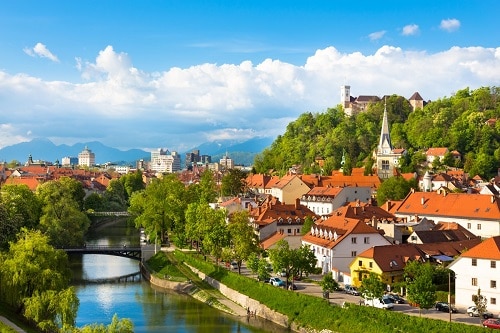
Triglav National Park
Triglav National Park is the only national park in Slovenia. Located in the north-western part of the country, it was established in its modern form in 1981.
Most of the park is made up of the Julian Alps, including the towering peak of Mount Triglav itself as well as the calm waters of Lake Bohinj. For spectacular views, you can attempt to hike Mount Triglav, or you can take the easy route and ride on the Vogel Cable Car Ride. The adventurous can also cross the Vintgar Gorge on a wooden footbridge from the 19th century or climb a steep staircase to see the rushing waters of the Savica Waterfall. Rafting on the Soca River is also a popular activity.
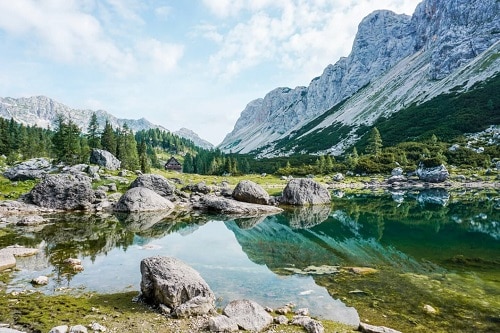
Your journey to Slovenia deserves to be marked by seamless exploration, and with So Easy Slovenia Travel Insurance, you’re not just insured; you’re equipped to explore with unmatched confidence. Choose us as your travel companion, ensuring a secure and memorable experience.

Travel Insurance
Travel Insurance, Schengen visa travel insurance, Europe and Worldwide Single Trip and Multi-Trip Insurance policies.
11 things to know before booking a trip to Slovenia

May 2, 2024 • 6 min read

Plan the perfect trip to Slovenia with these tips on booking, packing and activities © Olesya Baron / Shutterstock
I’ve been writing about Slovenia for Lonely Planet now for more than a decade.
On every trip, I’ve found Slovenians to be highly welcoming and proud of their country, particularly of Slovenia’s commitment to the environment and sustainability. English is widely spoken and you’re unlikely to have any problems hitting the ground running.
That said, a little local knowledge can help grease the wheels and make a trip to this beautiful country more rewarding and pleasurable. Here are some ideas and tips for how to prepare before you get there.
1. Book hotels and popular restaurants well in advance
By now, word has traveled far and wide about Slovenia’s immense physical beauty and its emerging rep as a high-end foodie destination. That means it’s no longer possible simply to turn up and expect to find accommodation bargains or tables at top restaurants. Ljubljana is popular year-round, so start your room hunt the moment you decide to visit. The same goes for Lake Bled and Lake Bohinj and the towns and resorts along the country’s Adriatic coastline. These all can get full to bursting in high season (July and August).
Top Slovenian chefs like Ana Roš, and her Michelin-starred restaurant Hiša Franko in Kobarid, have got gourmands around the world salivating at the very prospect of visiting the country. Book any restaurant with a whiff of foodie cred at least a month in advance.

2. Tack on an extra couple of days to your trip
Many travelers, regrettably, allocate just a long weekend or perhaps a week at most here. That may be enough time to get a sense of Ljubljana and possibly make a side trip to Lake Bled or the Adriatic coast, but it’s not enough for taking in all the sights Slovenia has to offer. The country may be small, but it packs in tremendous geographic diversity. After you’ve hit the main highlights, consider at minimum visiting the Soča Valley , the Goriška Brda wine communities, and the spectacular caves and landscapes of the Karst Region.
And certainly don’t overlook the east of the country, around cities like Maribor and Ptuj, which sees far fewer visitors than the Alpine and coastal regions of the west. In interacting with many, many travelers over the years, I’ve never once heard a visitor on returning home say they wished they’d planned to spend fewer days here.
Exploring Slovenia by car or bike? Here are the top road-trip routes
3. Call ahead when visiting wineries
A visit to a Slovenian winery, with a chance to meet the winemakers and sample the grape, is a highlight of any visit to the country. Prime tasting areas include Goriška Brda, Metlika, Brežice, Maribor, and many others. That said, resist the temptation simply to pull up at a winery gate and expect a tasting (as you might in other countries). It’s better to phone in advance or book a tasting over the winery website.

4. Take advantage of discount cards
Travelers are often reluctant to invest in city tourism cards out of skepticism for how much money they’ll actually save. In Slovenia, that's a mistake, as these cards can represent good value. The Ljubljana Card , sold at tourist information centers, includes free entry to many museums as well as unlimited travel on city buses, a free funicular to Ljubljana Castle , and bus transfer to Ljubljana Airport.
Additionally, students and people over 65 often qualify for discounted admission at museums and other attractions. When traveling with kids, look out for special “family” admission prices for up to two adults and two children.
5. Learn some Slovenian phrases
Slovenians are polyglots. In addition to English, many people speak German and Italian. However, it doesn’t hurt at all (and may even open some doors) if you can muster a few common phrases in Slovenian. Start off with dober dan , meaning “good day.” Prosim means “please,” and hvala is the way to say ”thank you.”
6. Get chatting with locals
Many Slovenians can be reserved in their daily interactions, but that doesn’t mean they aren’t friendly. Feel free to say hello to or ask questions of anyone you might meet. Most people will happily engage and pass along helpful information. Making contact goes beyond merely saying hi; it’s a great way to learn about the country. Don’t be surprised if a casual greeting leads to a longer chat over beer, coffee or schnapps. It’s all part of the culture.

7. Pack clothes for the outdoors
Slovenians enjoy getting out into the fresh air. Even if you’re just planning a city break in Ljubljana, you never know when you might get tempted by or pulled out on a hike. That means it’s best to bring along comfortable walking shoes (or boots if you’re planning on spending time in the higher elevations) as well as rain gear or a windbreaker (or whatever might be appropriate for the season). That said, don’t worry about packing too many fancy clothes. Slovenians aren’t overly dogmatic about fashion. When in doubt, go smart casual; even the most famous restaurants in the country keep it pretty chill.
8. Walk or cycle when you can
Slovenians love their cars, but wherever possible they often prefer to walk, hike or bike (rather than simply jump behind the wheel). It helps that well-marked walking and cycling trails crisscross just about every city, town and region in the land. Moving around on your own power isn't just a good way to keep fit, it's often faster and more convenient than waiting for public transportation . Ljubljana is a prime cycling territory, but pedestrians need to watch out so that they don't accidently walk into a designated cycling lane. That’s sure to earn a shrill bicycle bell and, potentially, a stiff word or two.
9. Be aware of ticks in open areas
Like much of Central Europe, Slovenia's forests and grasslands are filled with ticks. On hikes or treks, use repellents and cover up exposed skin. Always check your legs and arms after any prolonged hike or camping in the open air. Ticks can carry two serious diseases: tick-borne encephalitis and Lyme disease. The latter can sometimes be treated with antibiotics; the former is rarer but can only be avoided by prior vaccination. Mosquitoes can also be an annoyance around lakes and ponds in warmer months. Bring a good mosquito repellent just in case.
Looking to get outside? Here are our top hiking routes in Slovenia
10. Drive with caution in winter
Winters often bring treacherous ice and snow to Slovenian roadways, particularly in higher-elevation areas. Indeed, from November to April, many roads may be closed or impassable. These include the country's highest alpine circuit, the 1611m (5285ft) Vršič Pass , which typically shuts down in late October and reopens only in late April. The Traffic Information Center website has updated information on nationwide road hazards, closures and weather delays.
11. Know your limits before hitting the trails
Sadly, every tourist season brings news of a tragic accident, where someone misjudges the risks and takes unnecessary chances. While some Slovenian trekking routes are well-trodden – the country has more than 9000km (5590 miles) of trails – it's very easy to get off the beaten path, particularly at higher elevations.
It goes without saying (but it's worth repeating): always make sure you’re carrying the right equipment and be sure to seek local guidance before setting out. Consider hiring a local guide if in doubt. Let people know where you’re going and be mindful of changing weather conditions. If you have more-ambitious plans to tackle the multiple via ferrata routes (trails with permanent cables and ladders), bring along your own gear, like harnesses, lanyards, gloves and helmets. In any emergency on the trails, contact the Mountain Rescue Association of Slovenia (GRZS) by dialing 112.
This article was first published Mar 5, 2022 and updated May 2, 2024.
Explore related stories

Tips & Advice
May 2, 2024 • 8 min read
Slovenia is a fun-sized delight that packs some incredible sights and experiences into its borders. Here are the best places to visit when you get there.

Apr 27, 2024 • 4 min read

Mar 17, 2024 • 7 min read

Oct 20, 2023 • 8 min read

Aug 30, 2023 • 6 min read

Dec 15, 2022 • 2 min read

Feb 27, 2022 • 4 min read

Feb 20, 2022 • 6 min read

May 19, 2024 • 6 min read
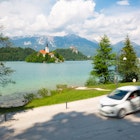
May 4, 2024 • 6 min read

Travel Insurance Slovenia
Slovenia, like other countries in the Schengen zone, has tightened entry rules for foreigners. Now medical insurance is a must-have requirement for visiting Slovenia. This includes visa-free travel with a biometric passport – if insurance was previously seen as a formality (for tourists), now it is checked for all incoming travelers.
What does medical insurance cover in Slovenia?
How much does tourist insurance cost for slovenia, how to apply for insurance for slovenia.
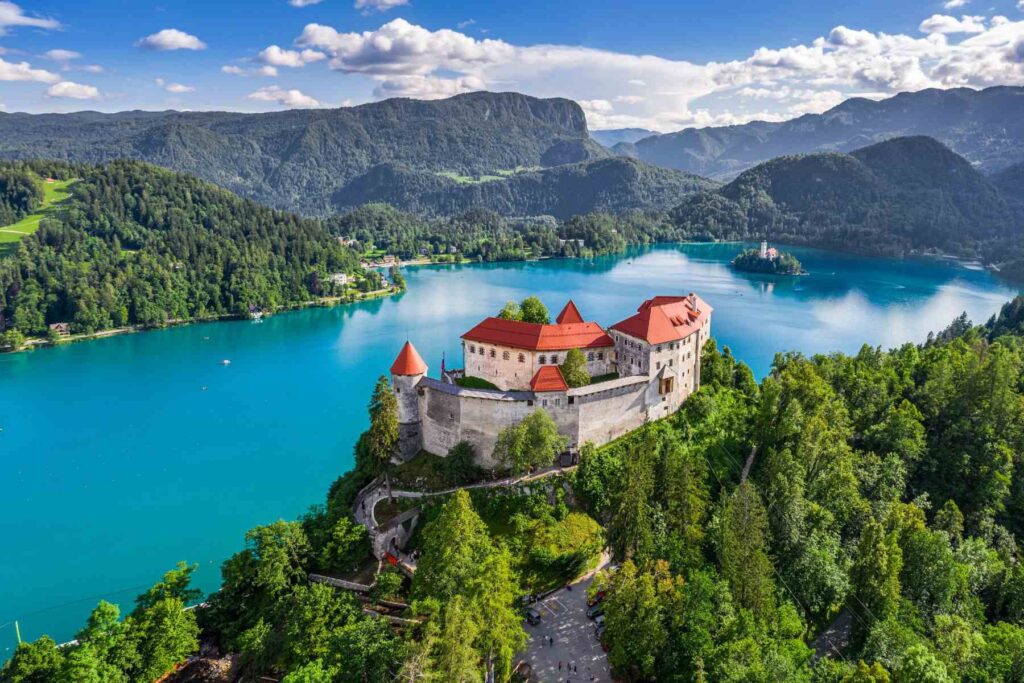
Tourist insurance in Slovenia includes compensation for the following cases:
- COVID-19 illness, observation, treatment, hospitalization;
- burns, frostbite;
- treatment of SARS and its complications;
- fractures, dislocations, sprains;
- injuries from animals;
- exacerbation of allergies;
- exacerbation of chronic diseases;
- explosion, lightning strike, electric shock.
For an additional fee, it is possible to add individual insurance cases. We also offer baggage insurance for loss and damage, as well as tickets (no departure, no show, flight cancellation, traveler’s change of plans) and package tours. Baggage insurance provides a percentage compensation if your baggage is lost or delayed during the flight.
Insurance for Slovenia is a money-saving option. You purchase an affordable policy and in case of an insured event, receive qualified medical assistance without hitting your budget.
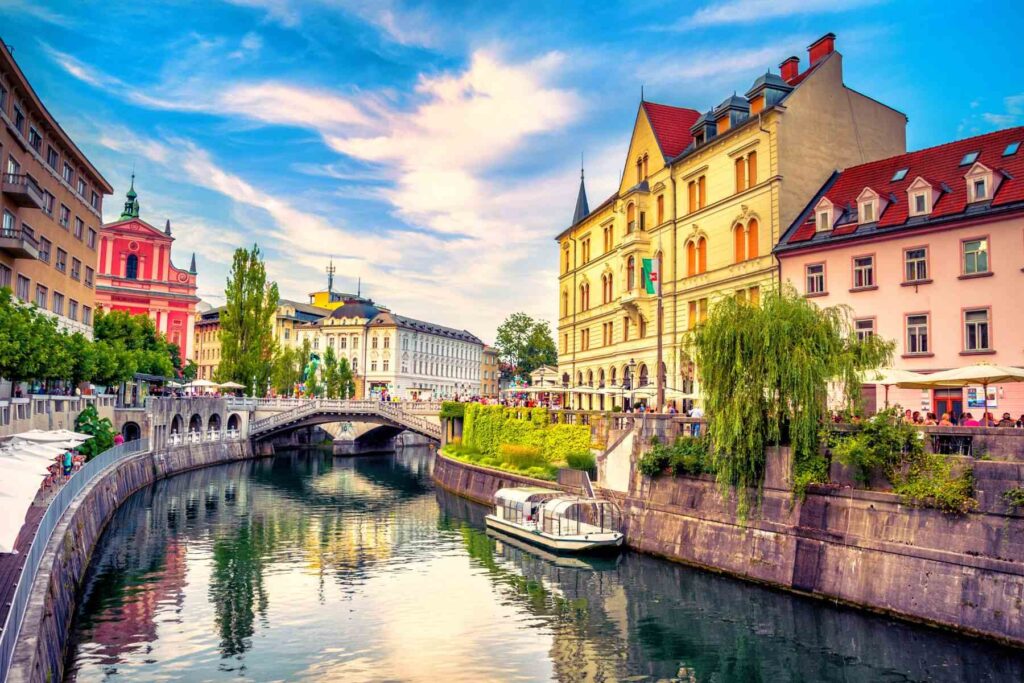
After selecting the tariff on the website, fill in the required fields – enter personal data (name, surname, date of birth) and the insurance period. Then pay the amount calculated by the online calculator on the website or through a convenient messenger, and the policy in Slovenia will be sent to your email. In case of an insured event, call the hotline or report the incident via Viber, WhatsApp, Telegram. We will assist you anywhere in the world and promptly resolve the issue.
Yes, you can. To do this, you need to contact us through the chatbot or messenger.
To have sports injuries covered, it is recommended to purchase a corresponding insurance policy. A regular medical insurance policy for a trip to Slovenia does not cover sports injuries.
You must immediately inform the company of any changes so that we can update your insurance policy.
The insurance policy applies exclusively to the countries specified in the policy.
A medical examination certificate is not mandatory to obtain an insurance policy.


Slovenia Travel Guide
Last Updated: April 18, 2024
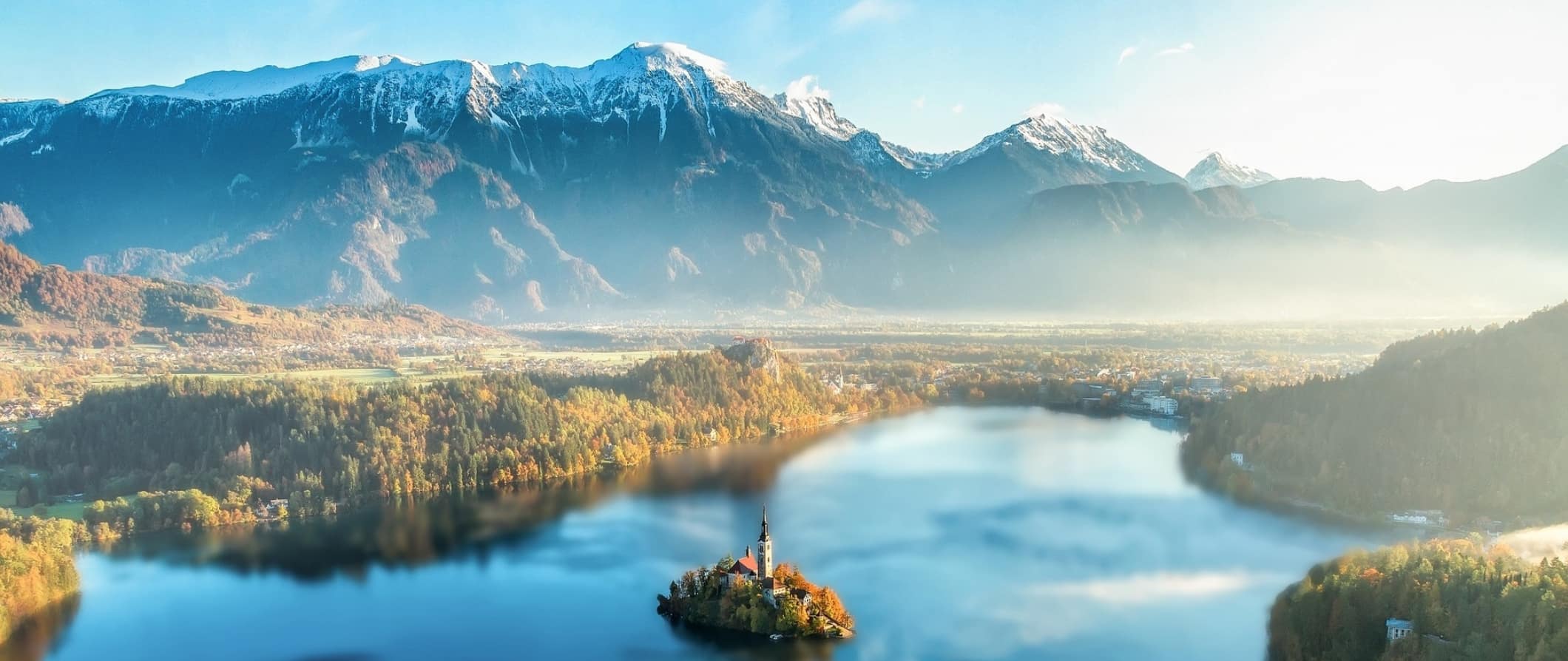
Slovenia is one of Europe’s least-visited destinations, which is crazy to me because it’s incredible! Known for its mountains, ski resorts, fabulous wine, extensive cave systems, incredible food, and postcard-perfect lakes, Slovenia offers all the beauty of Western Europe — but with a fraction of the crowds and for a fraction of the costs.
Ljubljana, the country’s vibrant capital, is considered one of the continent’s greenest and most livable cities while Lake Bled, Slovenia’s Insta-famous hotspot, is just as stunning in person as it is in photographs.
Inhabited since prehistory, the Romans established numerous outposts around present-day Slovenia. The region was later annexed by various powers, including the Holy Roman Empire and the Hapsburgs. Slovenia saw heavy casualties during World War I and was seized by Nazi Germany and Fascist Italy during World War II. After the war, the region was part of Yugoslavia until Slovenia (and Croatia) gained independence in 1991.
Today, this often-overlooked country is a favorite of hikers and history buffs, owing to its rugged landscape and contentious past. There’s a slew of outdoor activities here, making it the perfect destination for active travelers looking for less-crowded landscapes.
This travel guide to Slovenia can help you plan your trip, save money, and make the most of your visit to this incredibly undervisited country.
Table of Contents
- Things to See and Do
- Typical Costs
- Suggested Budget
- Money-Saving Tips
- Where to Stay
- How to Get Around
- How to Stay Safe
- Best Places to Book Your Trip
- Related Blogs on Slovenia
Click Here for City Guides
Top 5 things to see and do in slovenia.
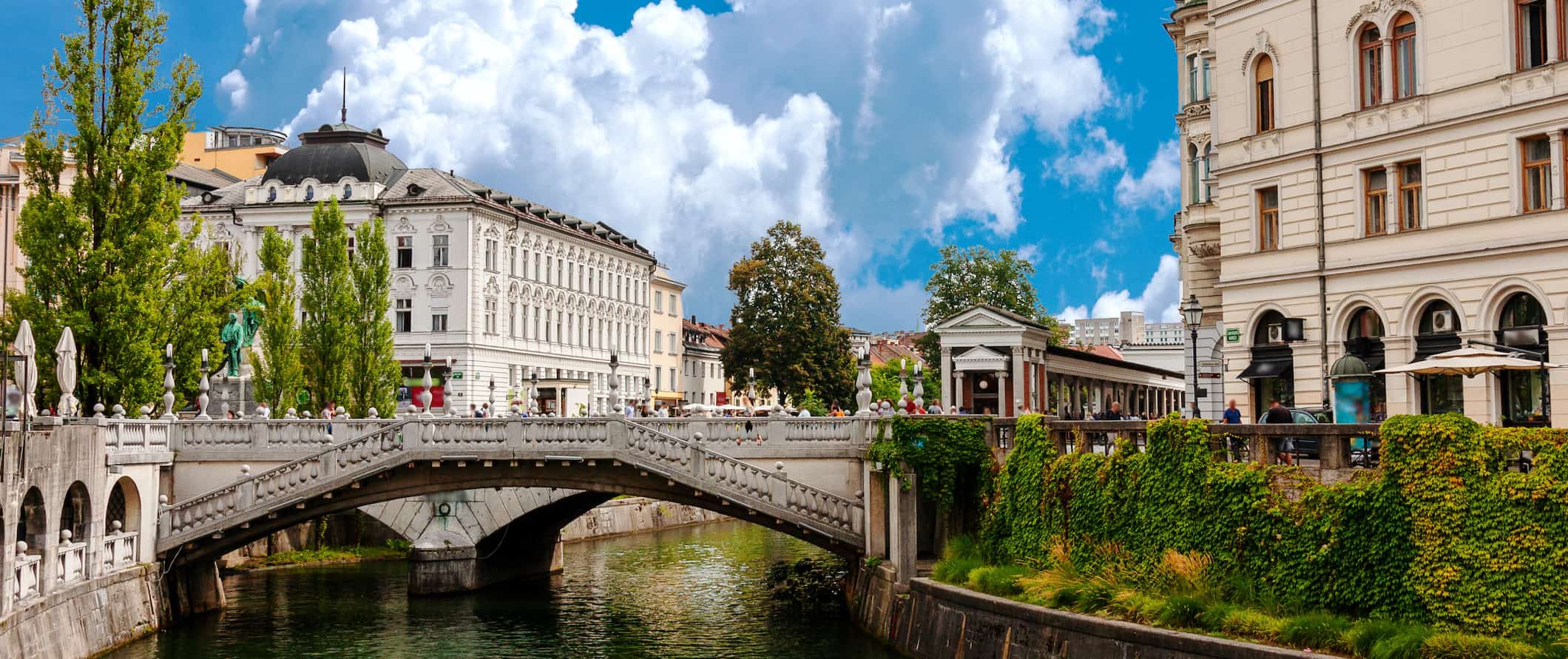
1. Wander Ljubljana
Ljubljana (pronouced lyoo-blyah-nuh) is a city built on myth and legend. According to Greek mythology, Jason and the Argonauts slayed a dragon here. Wander around the old town, gaze at the Baroque architecture, and climb the clock tower to take in the view.
2. Visit Piran
Piran is one of the most picturesque cities on the Adriatic coast. Its crown jewel is its old town, which is one of the best-preserved historical centers in the Mediterranean. Take in the historic Venetian architecture and relax in one of the many plazas.
3. Enjoy the views at Lake Bled
One of the most popular destinations in Slovenia, Lake Bled attracts thousands of visitors every year. Its main draw is the island in the middle of the lake, which is home to a 17th-century church. Visit the nearby Bled Castle overlooking the lake too (admission is 13 EUR).
4. Do some water sports
Slovenia has 7 sizeable lakes. From stand-up paddle boarding to kayaking to rappelling down waterfalls, there’s something for every fitness level and interest. Expect to pay around 15-20 EUR for a SUP or kayak rental and 65 EUR for a canyoning trip.
5. Go wine tasting
Wine lovers visiting Slovenia should head towards the Vipava Valley. Tucked beside the Italian border, the mild climate and closeness to the sea makes for ideal winemaking conditions. Expect to pay at least 150 EUR for a full day wine tour.
Other Things to See and Do in Slovenia
1. visit predjama castle.
Located one hour south of the capital, Predjama Castle was originally constructed in the 13th century. It is now a Renaissance-style castle with a Gothic façade, built right into the side of a cliff. (Fun fact: a Slovenian robber baron once called the castle home.) There’s also a “secret” tunnel that leads to the nearby Postojna Cave. The cave stretches over 24,000 meters and is open to the public (it’s the second-largest cave system in the country). Admission to the castle is 13.80 EUR, the cave is 25.80 EUR, and a combined ticket is 35.70 EUR.
2. Go hiking in Triglav National Park
The Triglav National Park is Slovenia’s only national park. Opened in 1981 and spanning 880 square kilometers (310 square miles), the park is named after the country’s tallest mountain. Thanks to its mountains, hills, lakes, waterfalls, springs, and rivers, the park is a magnet for hikers and outdoor enthusiasts. You can also kayak, raft, skydive, parasail, and even scuba dive here. It’s a beautiful park and well worth a visit. To extend your time in the park, you can stay overnight in one of the mountain huts (from 80 EUR) or the lodge (from 26 EUR). It’s free to visit the park, though some attractions require small fees to visit (generally 2-5 EUR).
3. Tour Ljubljana Castle
Ljubljana Castle was built in the 16th-century and boasts some of the best views of the city. Perched on Castle Hill above the city, you can take a self-guided tour and wander the grounds yourself or take a guided tour to learn more about the castle and its history. Inside the castle are several permanent exhibitions on its history, the Museum of Puppetry, an escape room, and a café and restaurant. Admission is 13 EUR and includes a guided tour and a return funicular ticket (since the castle is up a hill).
4. Hang out in Velika Planina
Located northeast of the medieval town of Kamnik, Velika Planina translates to ‘Big Pasture Plateau’ — and that is pretty much what it is. This huge, empty plateau is dotted by a handful of small traditional wooden houses surrounded by the towering snow-capped Alps. From June through September, the houses are used by local shepherds whose livestock graze on the plateau, creating a seasonal village open to tourists. Be sure to sample some of the amazing cheeses and local dishes (like barley stew or hota , a bean and sauerkraut hotpot). To get here you either need to drive to the top or take a 10-minute gondola lift ride from Kamniska Bistrica, a nearby village, which costs 17 EUR for a roundtrip ticket.
5. Tour the Skocjan Caves
Located one hour from Ljubljana, this enormous cavern system spans over 1,000 acres. It’s considered one of the most important cave systems in the world as it is one of the largest, home to a unique ecosystem. It has been inhabited since prehistoric times and there are underground streams and rivers, massive stone formations, and a 47-meter-high bridge you can cross. The caves have been in use for millennia, appearing in written sources as far back as the 2nd-century BCE. They are awesome! Guided tours start from 18 EUR. You can also arrange day trips from Ljubljana.
6. Go skiing
For the best skiing, head to Vogel in the Lake Bohinj area. It offers both downhill slopes and cross-country trails. The regular ski season lasts from December all the way until May. Expect to pay around 10-30 EUR for a lift pass. You can also get multi-day passes that bring down the price per day. Osovje, Luce, and Dole Pri Litiji are some of the most affordable places to ski if you’re on a budget.
7. Visit the Rogatec Open-Air Museum
The Rogatec Open-Air Museum is a small but fascinating living museum that highlights what life was like in rural Slovenia in the 19th and early 20th centuries. Located near the border with Croatia , you’ll learn about everything from basket weaving to blacksmithing to how livestock was kept and managed. Admission is 3 EUR. It’s a bit cheesy but if you have time (or are looking for a family-friendly activity), stop by!
8. Hike to Lovrenc Lakes
For an easy and beautiful hike that won’t take much time, head to Lovrenc Lakes. Located near Pohorje in the northeast, this one-hour trail begins at the Rogla Ski Center. Follow the wooden footpath that leads to the middle of the bog where there’s a viewing tower to climb for stunning views over across the marsh and forest. There are longer full-day trails and mountain bike paths too. Admission is free.
9. Do some underground cycling
Underground biking is one of the more unusual experiences that you may not find anywhere else. Near Mezica in the north, cyclists can explore the Slovenian underground by taking a tour underneath Mount Peca via its disused lead and zinc mine shafts. There are 5 kilometers (3 miles) of underground trails that you can explore with tours costing 40-50 EUR. You can also kayak sections of the underground mine too (tickets are the same price).
10. Drink beer from a fountain
The only beer fountain in the world is in the Slovenian town of Žalec. Located in the hop-growing capital of Slovenia, the Green Gold Fountain opened in 2016. Choose between six different beers to taste (including a green beer specially brewed just for the fountain). Simply buy a special mug for 8 EUR and sample each of the six beers on tap in the fountain. The fountain operates from April to October. Continue your beer adventure by visiting the nearby Eco-Museum of Hop-Growing and Brewing Industry in Slovenia.
11. Take a food tour
Slovenia travel costs.
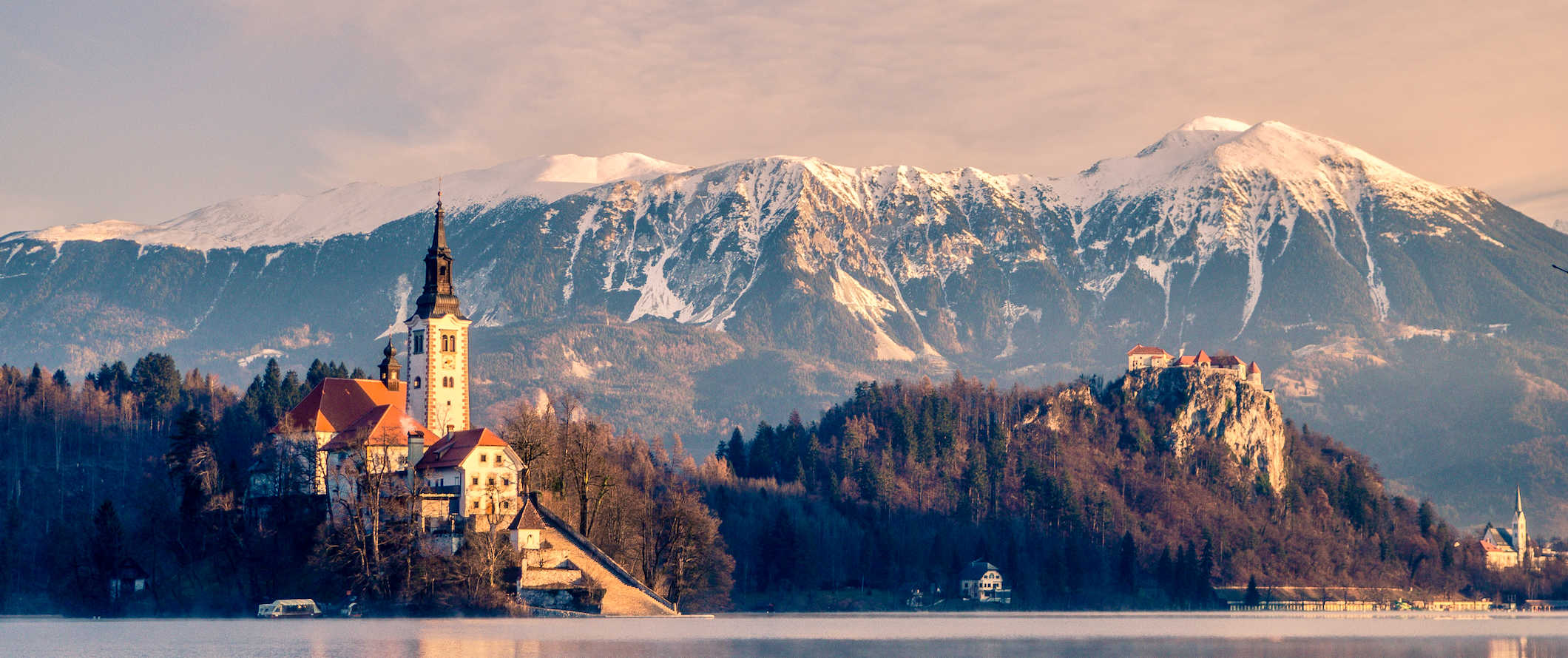
Accommodation – Hostel dorms with 4-6-beds cost 16-22 EUR per night. Free Wi-Fi is standard and self-catering facilities are common. For a private room, expect to pay 40-50 EUR per night.
Budget hotels start at 40 EUR per night. Many budget hotels include free breakfast (but not all do) so if you’re on a budget be sure to book a hotel that includes free breakfast.
Airbnb is another budget-friendly option in Slovenia, with private rooms starting at 35 EUR per night. For an entire home or apartment, expect to pay at least 70 EUR per night (though prices average double that if you don’t book in advance).
For those traveling with a tent, campgrounds are available around the country. Prices start around 12 EUR for a basic plot without electricity. Wild camping is illegal.
Food – Slovenian cuisine is influenced by Italian, Austrian, and Balkan cooking. Spicy sausage, goulash, and schnitzel make regular appearances and are easy to find in most restaurants. Burek , a flaky pastry filled with meat or cheese, is a local favorite for when you’re on the go. Other popular dishes are žlikrofi (potato-filled ravioli) and žganci (a porridge served with sauerkraut). On the coast, there’s plenty of mussels, fish, and squid.
An inexpensive dish at a restaurant serving traditional cuisine costs around 8-11 EUR, and a pizza costs about the same. International food, such as Thai and Indian cuisine, can only be found in the capital. Expect to pay between 7-13 EUR for a main dish.
Fast food (think McDonald’s) costs 6 EUR for a combo meal, though you can get a doner kebab for around 3 EUR. A beer costs 2.50-3 EUR, a glass of wine is 3-5 EUR, and a cappuccino or latte costs 2 EUR. Burek , the flaky pastry mentioned above, can be found in cafes around the country for 2-3 EUR.
If you want to splash out, a three-course meal at a restaurant serving traditional cuisine costs around 15-18 EUR, including a drink. Prices are closer to 25 EUR for a steak dinner with a drink.
Some of my favorite places to eat and drink were Restaurant Manna, Vino & Ribe, and My Dumplings of Slovenia.
If you are planning to cook your own food, a week’s worth of groceries costs 30-40 EUR for basic staples like meat, potatoes, cheese, pasta, and seasonal produce.
Backpacking Slovenia Suggested Budgets
On a backpacker budget, expect to pay around 50 EUR per day. This budget covers staying in a hostel dorm, cooking all of your meals, limiting your drinking, doing free activities like walking tours and hikes, and using local transportation to get around.
On a mid-range budget of about 120 EUR, you can stay in a private Airbnb room, eat out at budget-friendly for most meals, drink a bit more, do some castle tours, go cycling or kayaking, and take some taxis to get around.
On a “luxury” budget of 225 EUR per day or more, you can stay in a hotel, eat out for all your meals, take taxis everywhere, do as many activities as you want, rent a car, and book some private guided tours. This is just the ground floor for luxury though. The sky is the limit!
You can use the chart below to get some idea of how much you need to budget daily, depending on your travel style. Keep in mind these are daily averages — some days you’ll spend more, some days you’ll spend less (you might spend less every day). We just want to give you a general idea of how to make your budget. Prices are in EUR.
Slovenia Travel Guide: Money-Saving Tips
Slovenia is one of the cheaper countries in Europe. If you’re trying to save money, it’s easy to do so, especially since most of the outdoor activities are free. Here are some ways to save money in Slovenia:
- Take a free walking tour – Free walking tours are a fun and budget-friendly way to learn about a new destination. Ljubljana Free Tour has a free tour that covers all the major sites in the city. Just be sure to tip your guide at the end!
- Get the Ljubljana Card – This city card grants entrance to 20+ museums, a free guided tour, a trip on the funicular, a boat cruise, free public transportation, and a half-day bike rental. The card comes in 24, 48, and 72-hour versions costing 31-45 EUR respectively.
- Ride Flixbus – Flixbus is an affordable way to get around the country (and region). They have Wi-Fi, electrical outlets, and decent enough seats for overnight and long-haul bus journeys.
- Cook your own meals – If you’re on a tight budget, book accommodation that has a kitchen. Buying your own groceries may not be as glamorous as going out to eat, but it keeps your budget intact
- Stay with a local – Staying with a local via Couchsurfing (or a similar sharing economy site) is a great way to not only save money but you’ll meet knowledgeable locals who can help you better understand the city and its people.
- Walk everywhere – All of the major cities in Slovenia are quite walkable, so skip the public transportation if you want to save a few extra euros.
- Enjoy the free spaces – There are plenty of free parks as well as many free hiking trails around the country. Save your budget and enjoy the outdoors!
- Bring a reuseable water bottle – The tap water in Slovenia is safe to drink so bring a reusable bottle to avoid buying single-use plastic. LifeStraw makes bottles with a built-in filter so you can ensure your water is always clean and safe (it’s especially helpful if you’re out hiking).
Where to Stay in Slovenia
Slovenia has some great hostels in all the popular backpacker spots around the country. Here are some of my favorite places to stay in Slovenia:
- Hostel Vrba (Ljubljana)
- Aladin hostel (Ljubljana)
- Proteus (Postojna)
- Hostel Lukna (Mojstrana)
- Hosteller (Bled)
- Adriatic Piran (Piran)
- Uni Youth Hostel (Maribor)
How to Get Around Slovenia
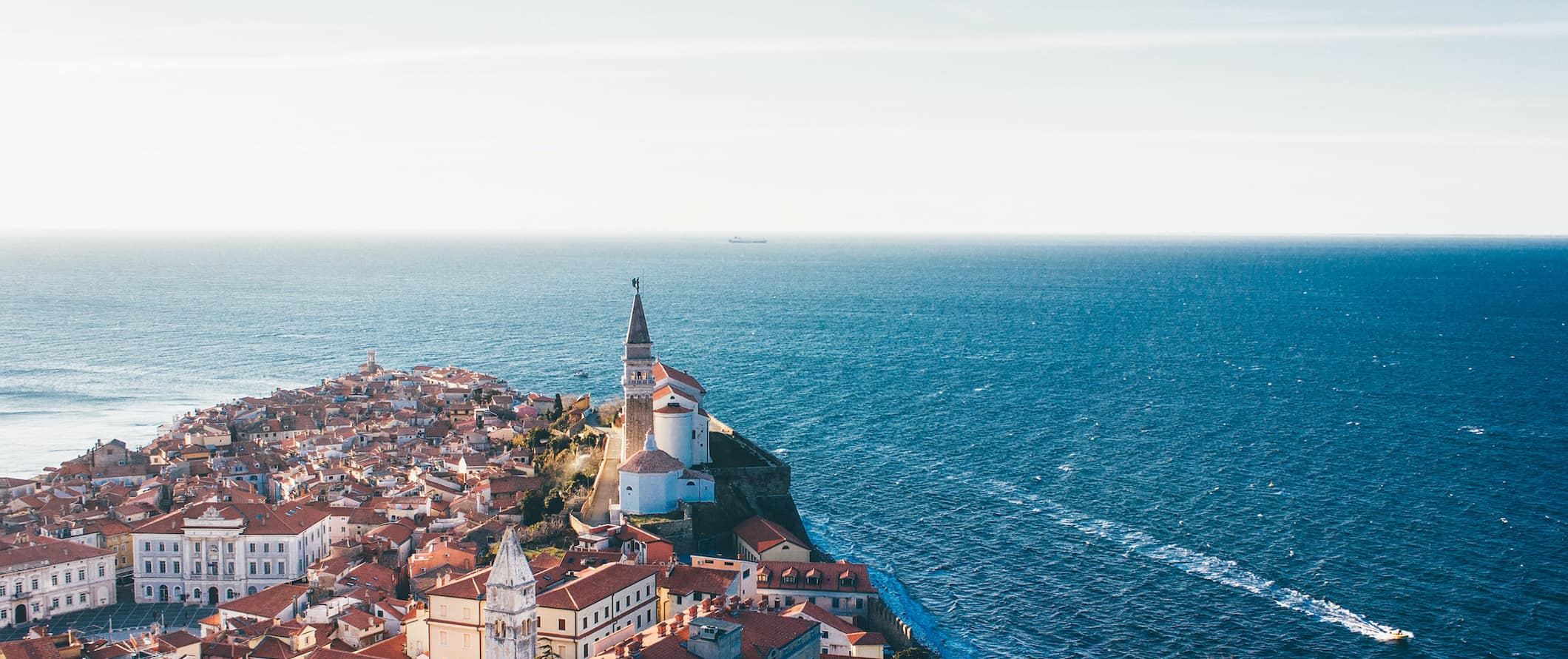
Public transportation – Public transportation prices vary by city but expect to pay around 1.20 EUR for a standard adult ticket.
Bus – Flixbus is one of the most budget-friendly ways to travel around Slovenia (and into neighboring countries as well). The 90-minute journey from Ljubljana to Bled is 5-9 EUR while the 75-minute bus ride from Ljubljana to Koper is 8-13 EUR. The 2.5-hour ride from Ljubljana to Zagreb, Croatia costs 12-18 EUR.
Train – Trains connecting Slovenia with other European cities run daily. Thanks to Slovenia being part of the Eurail network, it can be a great budget way to travel both internationally and domestically. This post has everything you need to know about the Eurail Pass .
Slovenia Railways is the sole company operating domestic trains. You can find the full timetable and pricing on their website. It is always better to buy your ticket in advance as prices can double if you buy them last minute.
The 2.5-hour train ride from Ljubljana to Koper costs 11 EUR while the hour-long trip from Ljubljana to Bled is 5 EUR. The trip to Zagreb, Croatia from Ljubljana takes around 2.5 hours and costs 24 EUR while the 3.5-hour journey to Graz, Austria is 13-18 EUR.
To find routes and prices for trains around Europe, use Trainline .
Fly – There are no domestic flights in Slovenia as it’s a small country.
Car rental – Car rentals cost around 25-30 EUR per day for a multi-day rental. Be sure to have an International Driving Permit (IDP) as you need one for the rental.
When to Go to Slovenia
While it is a small country, Slovenia has a very diverse climate in its three distinct regions. In the mountains of the north, there’s an alpine climate, the central lowlands have a more continental climate, and the west has a more Mediterranean climate.
Summer is the busiest and most popular time to visit. From June-August, the weather is much more reliable though prices rise slightly and there are far more tourists around (especially at Lake Bled). Expect daily highs around 23°C (73°F).
To beat the crowds, the best time to visit is during the shoulder season — either April-May or September-October. The weather is warm enough to hike and explore but you won’t have to compete with the growing number of visitors.
Unless you plan on skiing, it is probably best to skip the winter months. Slovenia gets cold and temperatures can drop below freezing.
How to Stay Safe in Slovenia
Slovenia is not just one of the safest places to visit in Europe — it’s one of the safest countries in the entire world. Ranking 6th on the Global Peace Index, Slovenia is a country where you can travel freely without any noteworthy concerns for your safety (the United States, for reference, is ranked 117th).
Of course, you still want to use some common sense. Don’t flash any valuables and keep an eye out for pickpockets in busy areas like public buses or bus/train stations. Always keep your valuables secure and out of reach just to be safe.
Solo female travelers should feel safe here, though the standard precautions apply (don’t leave your drink unattended at the bar, don’t walk home alone at night intoxicated, etc.).
If you rent a car, don’t leave any valuables in the vehicle overnight. Break-ins are rare but it’s always better to be safe than sorry.
If you experience an emergency, dial 112 for assistance.
While scams here are rare, to avoid getting ripped off, read my post on common travel scams to avoid.
Always trust your gut instinct. If a taxi driver seems shady, stop the cab and get out. If your hotel is seedier than you thought, get out of there.
The most important piece of advice I can offer is to purchase good travel insurance. Travel insurance will protect you against illness, injury, theft, and cancellations. It’s comprehensive protection in case anything goes wrong. I never go on a trip without it as I’ve had to use it many times in the past. You can use the widget below to find the policy right for you:
Slovenia Travel Guide: The Best Booking Resources
These are my favorite companies to use when I travel. They consistently have the best deals, offer world-class customer service and great value, and overall, are better than their competitors. They are the companies I use the most and are always the starting point in my search for travel deals.
- Skyscanner – Skyscanner is my favorite flight search engine. They search small websites and budget airlines that larger search sites tend to miss. They are hands down the number one place to start.
- Hostelworld – This is the best hostel accommodation site out there with the largest inventory, best search interface, and widest availability.
- Booking.com – The best all around booking site that constantly provides the cheapest and lowest rates. They have the widest selection of budget accommodation. In all my tests, they’ve always had the cheapest rates out of all the booking websites.
- Get Your Guide – Get Your Guide is a huge online marketplace for tours and excursions. They have tons of tour options available in cities all around the world, including everything from cooking classes, walking tours, street art lessons, and more!
- SafetyWing – Safety Wing offers convenient and affordable plans tailored to digital nomads and long-term travelers. They have cheap monthly plans, great customer service, and an easy-to-use claims process that makes it perfect for those on the road.
- LifeStraw – My go-to company for reusable water bottles with built-in filters so you can ensure your drinking water is always clean and safe.
- Unbound Merino – They make lightweight, durable, easy-to-clean travel clothing.
- Top Travel Credit Cards – Points are the best way to cut down travel expenses. Here’s my favorite point earning credit cards so you can get free travel!
Slovenia Travel Guide: Related Articles
Want more info? Check out all the articles I’ve written on backpacking/traveling Europe and continue planning your trip:

The 7 Best Hotels in London

10 Scotland Road Trip Tips You Need to Know Before You Go

The Perfect 7-Day Croatia Itinerary

The 6 Best Hotels in Copenhagen

The 6 Best Hotels in Florence

The 7 Best Hotels in Madrid
Get your free travel starter kit.
Enter your email and get planning cheatsheets including a step by step checklist, packing list, tips cheat sheet, and more so you can plan like a pro!

- Where To Stay
- Transportation
- Booking Resources
- Related Blogs
Travel insurance
We encourage all travelers to purchase Travel Insurance to protect their financial investment. We include the option to purchase travel insurance on all invoices and require that travelers decline coverage in writing should they wish to not purchase it. Our experience shows that guests who purchase travel insurance including trip cancellation, interruption, delay, baggage and personal effects loss travel more assuredly
This tiny island has the best beach in Europe. Did your favorite make the top 10?

Get more news like this delivered to your inbox by signing up for our Travel newsletter here .
Travelers love flocking to Europe to relax and recuperate at one of its many beaches .
It's no wonder why. Europe's diverse coastline is full of natural beauty, from the turquoise waters of the Mediterranean to the rugged cliffs of the Atlantic coast. These beaches are set against the backdrop of charming coastal villages and host iconic European beach clubs (Aperol Spritz, anyone?).
To help travelers find the perfect beach for their next Euro-trip, U.K.-based travel insurance comparison site Quotezone ranked Europe's most popular beaches, considering factors such as sea and air temperature, calmness of the water, TripAdvisor reviews and average cost to visit the destination (including food, drink and an overnight stay). The beaches spanned beloved destinations like Greece, Spain and Italy but also included lesser known locales such as Slovenia.
"Anyone planning a vacation to Europe should be sure to visit these beauty spots featured in our index, especially our top three hidden gems Cyprus, Malta, and Slovenia," CEO and travel insurance expert at Quotezone, Greg Wilson, told USA TODAY in a statement.
Learn more: Best travel insurance
Can't make it to Europe? Try Montreal for its European flair
Read below to find the best beaches in Europe.
10. Plage de Palombaggia in Corsica, France
Located in the Mediterranean Sea just south of mainland France, Corsica offers beaches comparable to the Caribbean with Plage de Palombaggia is one of the most popular beaches on the island. Think crystal-clear water, soft white sand and secluded coves. The beach scored the 10th spot on the ranking for is gentle waters and having over 3,300 five-star reviews. However, visiting the beach won't come cheap. Plage de Palombaggia is the most expensive beach on the ranking, costing €233 (about $259.73) for an overnight stay with food and drink.
9. Bournemouth Beach in Bournemouth, England
Tucked beneath cliffs, the sprawling Bournemouth Beach has been voted the top beach in the U.K. on TripAdvisor, offering rare warm waters for the country, a bustling pier and calm waters. Visiting the beach will be a bit costly for visitors – the beach is the second-most expensive on the index – clocking in at an average of €180 (about $200) for a one-day stay.
8. Playa de Maspalomas in Gran Canaria, Spain
Spain's Canary Islands are idyllic, offering diverse beaches made of black or golden sand. Playa de Maspalomas on the island of Gran Canaria is well-known for its lighthouse, rolling dunes and warm waters earned it a spot on QuoteZone's index. Surrounded by restaurants and hotels, visiting the beach will cost, on average, €151 (about $168).
7. Praia da Falesia in Algarve, Portugal
One of Portugal's most famous beaches, Praia da Falesia is worth the hype. The beach has an array of natural beauty on display – from sandstone cliffs to bright blue water – but also offers a lot to do. Visitors can check out the tide pools at low tide, swim or surf. Visitors can expect to pay around €137 (about $152) for a one-day stay.
6. La Pelosa Beach in Sardinia, Italy
Located on the second-largest island in the Mediterranean, Sardinia is a picturesque escape for travelers, and its beaches are no different. La Pelosa Beach's tranquil waters and white sands have made it so popular that you need to book your visit in advance, which will cost €3.50 (about $3.90). Staying near the beach is pricey, costing about €166 (about $185).
5. Zlatni Rat in Bol, Croatia
Translating to "Golden Horn," Zlatni Rat is a famous triangle-shaped beach on the Croatian island of Brac that extends into the ocean. As the tides and swells change, the beach also shapeshifts. Besides how stunning the beach is, it's also relatively inexpensive to visit, coming in as the second-least expensive beach locale on the index. For food, drink and a one-night stay, the average price is €96 (about $107).
4. Elafonissi Beach in Crete, Greece
Crete is beloved by travelers, and Elafonissi Beach is one of the Greek island's famous beaches. Depending on the season of your visit, you may encounter the iconic pink sand, but year-round, the beach is beautiful with calm azure waters. However, the beach isn't exactly tranquil, and gets quite crowded as the day goes on. To visit, the average cost is €184 (about $205).
3. Portoroz Beach in Portoroz, Slovenia
Nestled against the Adriatic Sea, Portoroz Beach is a gorgeous pebble beach fronting Portoroz's resort area, so you can take a break from the sun and stroll the promenade. The beach is also the cheapest on the index, costing €93 (about $103) on average for a one-day stay.
2. Mellieha Bay Beach in Mellieha, Malta
Not only is Mellieha a sheltered bay that provides gentle and warm waters, but it's also the largest sand beach in Malta, making it the perfect place for families. The beach scored high on the index for its warm temperatures and water. Visitors can rent sunbeds, swim, kayak and more. To visit, it will cost €117 (about $130) on average.
1. Nissi Beach in Ayia Napa, Cyprus
Earning the top spot on the index is the picturesque Nissi Beach in Cyprus – and rightfully so. The beach seemingly has it all: warm weather and water temperatures, and calm waters since it's located in a bay, has. In the near distance is a small island, adding to the natural beauty of the beach. "This destination ranked in the top spot across all factors, including water and air temperatures, waves, value for money and the number of 5-star reviews left by visitors," Wilson said. To visit for one night, it will cost approximately €103 (about $114).
Cookies on GOV.UK
We use some essential cookies to make this website work.
We’d like to set additional cookies to understand how you use GOV.UK, remember your settings and improve government services.
We also use cookies set by other sites to help us deliver content from their services.
You have accepted additional cookies. You can change your cookie settings at any time.
You have rejected additional cookies. You can change your cookie settings at any time.
Warnings and insurance
Before you travel.
No travel can be guaranteed safe. Read all the advice in this guide. You may also find it helpful to:
- see general advice for women travellers
- read our guide on disability and travel abroad
- see general advice for LGBT+ travellers
- read about safety for solo and independent travel
- see advice on volunteering and adventure travel abroad
Travel insurance
If you choose to travel, research your destinations and get appropriate travel insurance . Insurance should cover your itinerary, planned activities and expenses in an emergency.
About FCDO travel advice
The Foreign, Commonwealth & Development Office ( FCDO ) provides advice about risks of travel to help you make informed decisions. Find out more about FCDO travel advice .
Follow and contact FCDO travel on Twitter , Facebook and Instagram . You can also sign up to get email notifications when this advice is updated.
Related content
Is this page useful.
- Yes this page is useful
- No this page is not useful
Help us improve GOV.UK
Don’t include personal or financial information like your National Insurance number or credit card details.
To help us improve GOV.UK, we’d like to know more about your visit today. Please fill in this survey (opens in a new tab) .
Health & Dental Quotes
- Health Insurance
- Dental Insurance
- Group Benefits
- Disability Insurance
- Critical Illness Insurance
Life Insurance Quotes
- Life Insurance
- No Medical Life Insurance
- Mortgage Life Insurance
- Funeral Insurance
Home and Auto Quotes
- Auto Insurance
- Home Insurance
- Condo Insurance
- Renters Insurance
Pet and Travel Quotes
- Travel Insurance
- Snowbird Travel Insurance
- Super Visa Insurance
- Pet Insurance
- Affordability Calculator
- Closing Cost Calculator
- Payment Calculator
COMPARE CREDIT CARDS
- Best Credit Cards in Canada
- Best No Annual Fee Credit Cards
- Best Rewards Credit Cards
- Best Cash Back Credit Cards
- Best Travel Credit Cards
- Best Business Credit Cards
- Best Student Credit Cards
- Best Credit Score Builder Cards
- Best Low Interest Credit Cards
- Best Balance Transfer Credit Cards
- Best No Foreign Exchange Credit Cards
OUR FEATURED CREDIT CARDS
- Neo Financial
CREDIT CARD REVIEWS
- Neo Financial Review
- Tangerine Money-Back Credit Card Review
- Scotiabank Value Visa Card Review
- Scotiabank No Fee Credit Cards Review
- Refresh Financial Secured Credit Card Review
- HBC Mastercard Review
CREDIT CARD GUIDES
- Annual Fee on a Credit Card - Is It Worth It?
- The Difference Between Mastercard and Visa: Answering Your Questions
- Purchases You Should Always Charge on Your Credit Card
- Why Having More than One Credit Card Makes Sense
- Spend to Earn: How to Earn Credit Card Reward Points Quickly
- Building Credit with a Credit Card
- Charge Card vs Credit Card: Understanding the Difference
- Easy Ways to Lower Your Credit Card Interest Rates
- Secured vs Unsecured Credit Card; The Best Way to Build Credit
- Personal Loans
- Business Loan
- Debt Relief
- Bank Accounts
- Free Credit Score
- Provincial Health Insurance Plans
- Insurance Companies
- Insurance Forms
- Insurdinary Reviews
CANADA RESOURCES
- My Service Canada Account: Step-by-Step
- SIN Number Application: Step-by-Step
- My CRA Account: Step-by-Step
- Canada Immigration 101
- Home 101: Understanding Your Home
- First-Time Home Buyer Guide in Canada
- Tax Resource for Canadians
- Beginner's Guide for New Drivers
- Canada's Food Guide
- Common Law Guide in Canada
- Pregnancy Guide for Canadians
- Renters and Landlords Guide
- Retirement Guide in Canada
- Best Places to Live in Canada
- Best Places to Retire in Canada
- 11 Best Places to Visit in Canada in the Wintertime
- Best Travel Destinations in Canada
- Best Travel Destinations for Canadians
- How to Log In
- How to Submit Claims
- 9 Benefits of Using A Health Insurance Broker
- Health Insurance for International Students in Canada
- The Complete Guide to Life Insurance
- Ultimate Guide to Buying Life Insurance at Every Age
- Best Life Insurance Options for Seniors
- Understanding Life Insurance for Children
- Understanding Life Insurance for Couples
- 6 Life Insurance Mistakes to Avoid
- Life Insurance for Drug Users
- Can Smokers Get Life Insurance
- Can Alcoholics Get Life Insurance
- Can I Get Life Insurance If I Have Asthma
- Can I Get Life Insurance If I Have Diabetes
- Can I Get Life Insurance If I Have Epilepsy
- Can You Get Life Insurance After A Stroke
- Can You Get Life Insurance with Cancer
- Canadiens Vs Maple Leafs - Digging Into The Rivalry
- How to Speak Canadian the Right Way
- Canada Road Trips
- How to Have a Side Hustle in Canada
- Top 5 Tourist Places in Each Province Revealed
- Top 5 Places to Go Glamping in Canada
- Best Free Tax Return Software for Canadians
- What Not to Post on Social Media while Traveling
- The Average Cost of Raising a Child in Canada
- The Real Cost of Owning A Pet in Canada
- The Real Cost to Build a House in Canada
- The Real Cost of Owning a Cottage in Canada
- The Real Cost of Owning a Boat in Canada
IN THE PRESS
- Insurdinary Surpasses 1000 Reviews!
- How Insurdinary Rakes in Great Reviews
- Optimize Your Finances with Insurdinary’s Expense Tracker App
- Insurdinary's Online Life Insurance Quoter: How It Works
- APOLLO Insurance Partners with Insurdinary
RESEARCH STUDY
- How COVID-19 Impacted Your Opinion on Life Insurance
- How COVID-19 Impacted Your Opinion on Travel Insurance
- Injured or Hospitalized While on Vacation
- How Do You Prefer to Buy Life Insurance
- Compare. Save. Get the Best Rates. Get Quotes Contact Us

Slovenia Travel Insurance
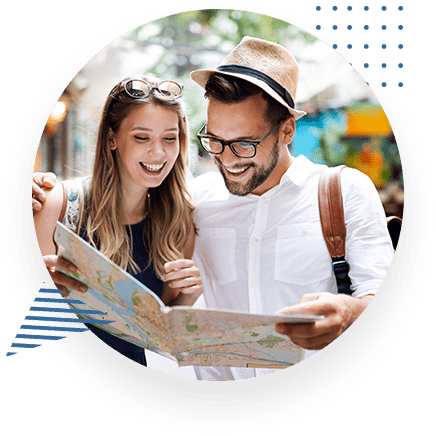
Travel Insurance Overview
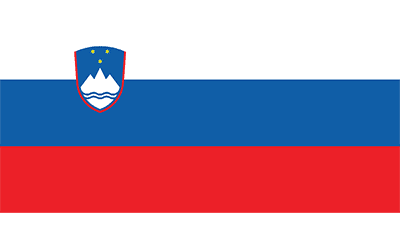
With a romantic fairytale setting, Slovenia is one of the most attractive locations in Europe for tourists. Slovenia was named European Green Capital in 2016 due to the importance placed on Green living in the country. Slovene dishes and cuisines are world-class. Ljubljana offers remarkable fresh local produce that underlies the wide-ranging dishes in the European country.
Canadians visit Slovenia for tourism, trade, education, and several other purposes. The two countries have an excellent relationship with each other. There are 37,000 Canadians of Slovene ancestry in Canada. Youth mobility is also an important form of the relationship between the countries. The two countries signed a Youth Mobility Agreement in 2009. The agreement allows Canadian and Slovenian youths between 18 and 35 to work and live in each other country.
No matter your reason for traveling to Slovenia, you need to have the right Slovenia travel insurance before you leave Canada. Your provincial plan will not cover you abroad in case of medical emergencies. However, with the right travel insurance or private medical plan, you will be adequately covered.
To get an instant quote on Slovenia travel insurance, click here .
Travel Insurance Details
Basic information about slovenia.
Some important information on Slovenia Travel Insurance that we think you’ll want to know before you travel.
To read more about Slovenia travel insurance, click here .
Speak To An Expert
Slovenia security measures for travelers.
The decision to travel to Slovenia is your choice and you are responsible for your personal safety abroad. But since we care about your safety, we provide you credible and reliable information in our Travel Advice to help you to make a well-informed decision when you travel out of Canada.
Slovenia – Take normal security precautions
Entry / Exit requirements
Every territory or country decides who enters or exits its borders. Also, the Government of Canada cannot intervene on your behalf if you do not meet the country’s entry or exit requirements.
The information on this page was obtained from the Slovene authorities; however, it can change at any time. Moreover, you can verify the information with foreign diplomatic missions and consulates in Canada.
The entry requirements that apply to you depend on the type of passport you use for travel. Check with your transportation company to find out about passport requirements before you leave.
- Regular Canadian Passport - Since Slovenia is a Schengen area country, you are expected to hold a passport valid for a minimum of 3 months beyond your duration of stay in Slovenia.
- Passport for official travel - Different rules may apply. Learn more about official travel here .
- Other travel documents - The entry rules that apply when traveling with a temporary passport or an emergency travel document may differ. Find out about entry rules from the closest diplomatic mission for Slovenia before you leave.
Useful Links
- Foreign diplomatic missions and consulates in Canada
- Canadian passports
To learn more about Slovenia travel insurance, click here .
Slovenia Healthcare
Slovenia has both public and private health care system. The quality of health care in the European country is high but medical treatment could be expensive. Some hospitals in Slovenia may require cash payments. So, you need to travel with enough money to cover potential costs and an adequate Slovenia travel insurance policy for the coverage you need against medical emergencies.
For more information about healthcare in Slovenia, click here .
Slovenia Travel Insurance News
After living in Canada for over nine years, Robert Zaveljcina and Michaela Jokic-Zaveljcina were given deportation notices. Their two-year-old son, Michael Zaveljcina and his seven-month-old brother Alex, both born in Peterborough, will be deported to Slovenia with their parents, despite the fact that the children have never been to Slovenia.
Eager to build a new life, the Zaveljcina began working as soon as they were legally able to do so. After seven years, they felt secure enough to build their family. Father Bill Moloney who baptized Michael and Alex said he does not know what is happening. He added that the children are the sweetest little kids and their parents are giving them a great example. Father Moloney asked people to be emphatic and cry out that it is unjust.
The Zaveljcinas moved to Peterborough after being faced with discrimination in Slovenia. Mr. Zaveljcina was a Slovenian but his wife was half-Croatian and half-Serbian. Many of his fellow Slovenian back home see the marriage as a betrayal because most Slovenians harbor hatred towards the other nations of the former Yugoslav Republic.
Mr. Zaveljcina said they love Canada because it gives everyone a chance. He added that they want their children to grow up learning that everyone is equal and that their race does not matter.
To learn more about Slovenia travel insurance news click here .
Travel Insurance Related Pages
Slovenia travel insurance faq, do you need a visa for travelling to slovenia.
Canadians do not need a visa to enter Slovenia for stays up to 90 days whether for tourism, business or to study in the country since Slovenia is a Schengen area country. If you intend to reside in Slovenia for more than 90 days, you need a resident visa. It should be noted that stays in the Schengen area are cumulative. This means that the 180-day period will be counted even if you travel to another Schengen area country.
To learn more about Slovenia travel insurance and visa, click here .
Can I buy multiple travel insurance policies?
You can purchase multiple Slovenia travel insurance policy if you are not satisfied with the features and benefits offered by a single policy.
Does travel insurance cover doctor visits?
Your Slovenia travel insurance covers the cost of outpatient services including doctor visits.
Can I buy travel insurance the day I leave?
You can buy Slovenia travel insurance the day you leave Canada or even later. Some insurers offer usage-based policies which make it easy for you to purchase coverage anytime.
How long does a travel insurance claim take?
The length of time it takes to receive an outcome for your claim depends on the type of claim. However, if you provide necessary documents to your insurer, you should get an outcome in 10-14 business days.
The World’s Trusted Company
Rating based on more than 1,000 reviews from around the world
Call, we're online
- Water Skiing
- Kitesurfing
- Wakeboarding
- Windsurfing
- Snowboarding
- Ice Climbing
- Snowmobiling
- Hang Gliding
- Paragliding
- Hot Air Balloon
- Mountain Hiking
- Rock Climbing
- Mountain Biking
- Bungee Jumping
- Base Jumping
- Horse Riding
- Motorsports
- American Football
- Dominican Republic
- Czech Republic
- Switzerland
- Netherlands
- United Kingdom
- South Africa
- Philippines
- Saudi Arabia
- South Korea
- New Zealand
- Multi Trip Travel Insurance
- Single Trip Travel Insurance
- Annual Travel Insurance
- Group Travel Insurance
- Schengen Travel Insurance
- Travel Insurance for Visas
- Worldwide Travel Insurance
- Top Up Travel Insurance
- Legal information
- Validate insurance policy
Cooperate with us
- --> --> -->